Colorado Field Coordinator
ABOUT TROUT UNLIMITED
Trout Unlimited is a national organization with 300,000 members and supporters organized into over 400 chapters and councils nationwide. These dedicated grassroots volunteers are matched by a respected staff of organizers, lawyers, policy experts, and scientists, who work out of more than 45 offices across the country. Our mission is to conserve, protect, and restore North America's cold-water fisheries and their watersheds.
POSITION SUMMARY
Some of the best hunting and fishing in the West today is found on public land where intact habitat provides all the necessities for healthy populations of wild and native fish as well as trophy herds of elk, deer and other big-game animals. Trout Unlimited's Sportsmen's Conservation Project is looking for a field coordinator to work in Colorado.
We are seeking a staff member to design and implement campaigns that engage hunters and anglers in public land decision-making processes on high-quality fish and wildlife habitat. Denver location preferred, Colorado Front Range communities acceptable.
DUTIES AND RESPONSIBILITIES
- Grassroots organizing with local and state hunters/anglers, organizations, local businesses and community leaders.
- Working with local elected officials, legislative officials, and state and federal land management agencies.
- Leading a team-oriented, collaborative effort to maintain and protect the great fish and wildlife values in the area.
- Assist in fundraising.
- Non-supervisory position.
- Will be responsible for helping develop and implement campaigns within allocated budgets.
This is not an all-inclusive list of duties and responsibilities.
QUALIFICATIONS
- Bachelor Degree preferred, will consider experience in lieu of education.
- Knowledge of public land issues and agency planning processes a plus.
- Experience in developing and leading advocacy-oriented campaigns preferred.
- Excellent written and oral communication skills.
- Ability to work independently and be a self-starter.
- Positive attitude with energy and willingness to do what it takes to get the job done.
- Flexibility, adaptability.
- Proficient in Word, Excel, PowerPoint and Outlook.
- Very strong inter-personal skills.
- Avid angler/hunter a plus.
- Strong organizational and time management skills.
- Fundraising experience preferred.
HOW TO APPLY
Please send a letter of interest and resume to Katie Becker, kbecker@tu.org. No phone calls, please. Open until filled.
Please fill out this voluntary form and submit it as an attachment to this email address.
TU is an Equal Employment Opportunity & Affirmative Action Employer pursuant to Section 503 of the Rehabilitation Act & Vietnam Era Veterans Readjustment Assistant Act.
TU hires staff without regard to race, color, religion, national origin, age, gender, sexual orientation, marital status or disability.






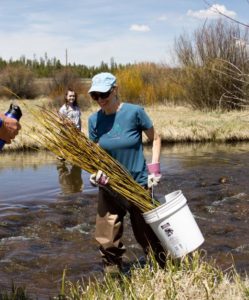 The group’s inaugural project at Fraser Flats aimed to restore a roughly one-mile stretch of the Fraser between the towns of Tabernash and Fraser, with the goal of providing healthy habitat for trout even during periods of reduced flows. The Fraser in this section had become too wide and shallow, resulting in sedimentation and high temperatures that smothered bug life and pressured coldwater-loving trout.
The group’s inaugural project at Fraser Flats aimed to restore a roughly one-mile stretch of the Fraser between the towns of Tabernash and Fraser, with the goal of providing healthy habitat for trout even during periods of reduced flows. The Fraser in this section had become too wide and shallow, resulting in sedimentation and high temperatures that smothered bug life and pressured coldwater-loving trout.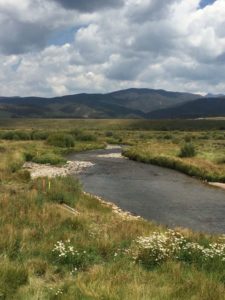 Colorado Parks and Wildlife conducted a fish survey on Oct. 5, shortly after completion of the project, and found dramatic increases in the biomass of brown and rainbow trout in the stretch compared to previous surveys, and an even larger increase in numbers of larger (14" and up) fish.
Colorado Parks and Wildlife conducted a fish survey on Oct. 5, shortly after completion of the project, and found dramatic increases in the biomass of brown and rainbow trout in the stretch compared to previous surveys, and an even larger increase in numbers of larger (14" and up) fish. CPW set up at the Zimmerman Lake inlet to capture spawning Greenbacks.
CPW set up at the Zimmerman Lake inlet to capture spawning Greenbacks. Fish were collected with a large net and put into a pen to be sorted and categorized by CPW staff and volunteers.
Fish were collected with a large net and put into a pen to be sorted and categorized by CPW staff and volunteers.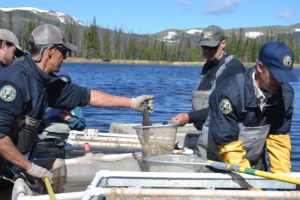 Fish were sorted based on their gender and stocking year.
Fish were sorted based on their gender and stocking year.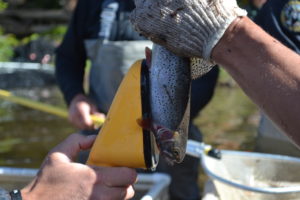 RFID chips in the fish help to identify the stocking year and other critical data.
RFID chips in the fish help to identify the stocking year and other critical data.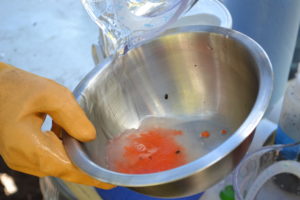 After the fish were sorted, CPW milked the males and females - making targeted genetic crosses among the various lineages to expand the genetic diversity. The eggs and sperm were combined in bowls, packed into small coolers, put on ice, and shipped to the local fish hatchery in Leadville, CO for breeding.
After the fish were sorted, CPW milked the males and females - making targeted genetic crosses among the various lineages to expand the genetic diversity. The eggs and sperm were combined in bowls, packed into small coolers, put on ice, and shipped to the local fish hatchery in Leadville, CO for breeding. Back in the 1960’s planners thought that Aspen’s population (1,101 in 1960) would reach 30,000 by the end of the century and that additional water supplies would be necessary. Aspen’s population didn’t grow much. In 2000 it was up to 5,914 and by 2010 had added less than a thousand more. Looking forward, the City’s population isn’t expected to grow much more over the next 60 years either, yet Aspen continues to hang on to the notion that they might, someday, need these destructive dams and reservoirs.
Back in the 1960’s planners thought that Aspen’s population (1,101 in 1960) would reach 30,000 by the end of the century and that additional water supplies would be necessary. Aspen’s population didn’t grow much. In 2000 it was up to 5,914 and by 2010 had added less than a thousand more. Looking forward, the City’s population isn’t expected to grow much more over the next 60 years either, yet Aspen continues to hang on to the notion that they might, someday, need these destructive dams and reservoirs.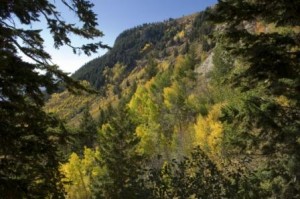
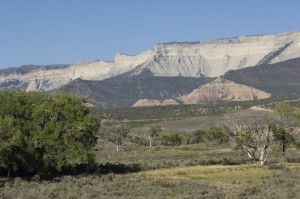 The MLP process is a new tool that promises to address some of that top-down, fragmented approach to public land management. To their credit, the BLM is listening and incorporating suggestions from local ranchers, conservation groups and elected officials into their leasing plan for South Park.
The MLP process is a new tool that promises to address some of that top-down, fragmented approach to public land management. To their credit, the BLM is listening and incorporating suggestions from local ranchers, conservation groups and elected officials into their leasing plan for South Park.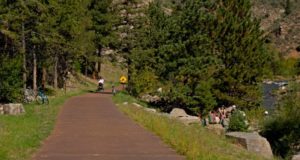 The trail includes not only 3 miles of a paved multiuse trail, but features 3 bridges, 6 new formal river access points and multiple overlooks and boulder seating areas. Other improvements include two new parking lots and an expanded parking lot and restroom at Mayhem Gulch. The parking lots are a key component to bringing a new types of visitor to Clear Creek Canyon; cyclists, hikers and walkers.
The trail includes not only 3 miles of a paved multiuse trail, but features 3 bridges, 6 new formal river access points and multiple overlooks and boulder seating areas. Other improvements include two new parking lots and an expanded parking lot and restroom at Mayhem Gulch. The parking lots are a key component to bringing a new types of visitor to Clear Creek Canyon; cyclists, hikers and walkers.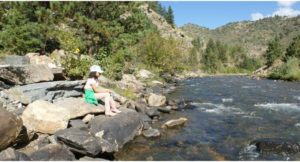 t was encouraging to see extended families walking the trail, leaning over the guardrail at an overlook pointing to trout rising behind a large boulder. Joggers pushing strollers paused at the overlooks on the bridges to catch their breath. Cyclists were numerous and one group took advantage of the informal boulder seating areas to stop for a picnic lunch. There were crowds of climbers at all of the popular areas, and fisherman were ducking in and out of the willows along the banks.
t was encouraging to see extended families walking the trail, leaning over the guardrail at an overlook pointing to trout rising behind a large boulder. Joggers pushing strollers paused at the overlooks on the bridges to catch their breath. Cyclists were numerous and one group took advantage of the informal boulder seating areas to stop for a picnic lunch. There were crowds of climbers at all of the popular areas, and fisherman were ducking in and out of the willows along the banks.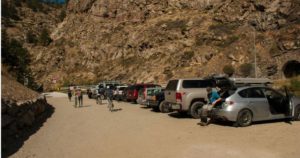 My overall impression of the trail was extremely positive. The materials used through compliment the character of the Canyon. The improved parking areas provide additional spaces and greatly improve visitor safety and the new signage is clear and concise. The biggest improvement; however, is the trail. It allows visitors to disconnect from Highway 6 and truly immerse themselves in the Creek, the Canyon, and the Landscape.
My overall impression of the trail was extremely positive. The materials used through compliment the character of the Canyon. The improved parking areas provide additional spaces and greatly improve visitor safety and the new signage is clear and concise. The biggest improvement; however, is the trail. It allows visitors to disconnect from Highway 6 and truly immerse themselves in the Creek, the Canyon, and the Landscape.
